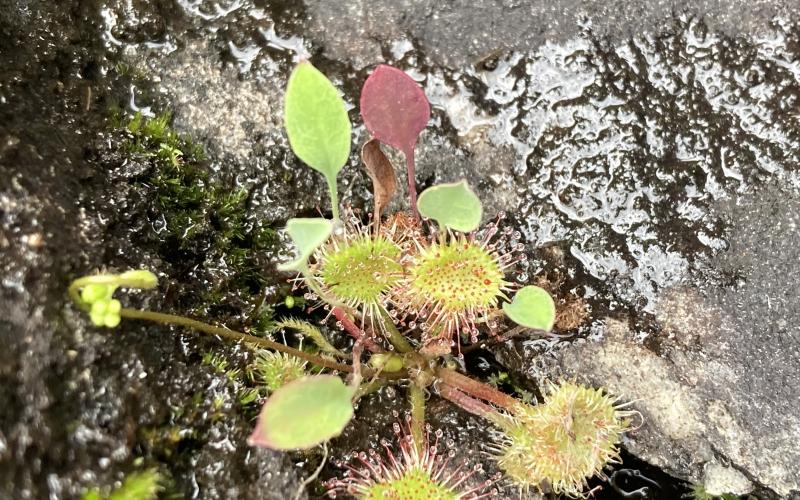Jessica Webb
editor@thesmokymountaintimes.com
When the Blue Ridge Parkway was created, it took blasting and drilling through sections of rock. In some spots where rockface is still exposed along the road—extending up several stories—water continued a steady trickle dripping, dripping, dipping. This has created a perfect environment for many unique plant species to thrive along the vertical bog.
On Friday morning, July 14, Adam Bigelow of Bigelow’s Botanical Excursions, led a group of 10 people on one of the slowest and shortest wildflower walks to explore this unique spot.
The fog swept across the balsams, and the air was cool and crisp as the group gathered at the overlook at a cool 5,500 feet above sea level.
Bigelow promised it would be an easy, short walk in advance of the event, but when they gathered, he joked that folks ready for a hike would be underwhelmed— “This is it,” he said, pointing across the road to the vertical bog along the rocks.
The conditions, he explained, have led to “super rare and special species of plants you don’t find anywhere else.”
The vertical bog is one of his, and other plant nerds’ favorite spots, known for among other finds more than five species of St. John’s Wort.
There’s also an interesting relationship that happens at this high elevation, he shared, where you can find plants growing in the Southeast that are more often found in Maine or upstate New York.
Bigelow added a safety note before taking the group across the road to begin the slow study of the many unique and wonderful plants. The focus began on yellow flowers, starting with one of the St. John’s Wort species, Buckley’s or Appalachian St. John’s Wort. The plant can be identified by its rounded, bluish-green leaves and how its leaves grow in a circular pattern so each section allows the others below it to catch the sunlight.
As the walk continued, the sound of Bigelow’s voice carried against the echo of the rocks with the constant trickle of water flowing down the rocks. Participants snapped photos, played the “What’s that plant?” game between the occasional yell of “car,” a safety warning to stay clear of the traffic.
There were the smallest of blooms- from two types of bluets, which are distinct with their four petals- to Southern bush honeysuckle, which Bigelow said grows well in gardens but should not be confused with Japanese honeysuckle or bush honeysuckle, both invasive species. He has one growing in his own yard, he said, pointing out the yellow, tubular flowers attract not just bees but hummingbirds as well.
At the walkers’ feet was a slow-moving water flowing down alongside the parkway road that was filled with multiple species of grasses, sedges and rushes, along with stretches of sphagnum moss.
One small, fun find along the rockface was the carnivorous round-leaved sundew. Bigelow explained it releases a sweet, sticky substance that attracts insects that then get stuck on it. Once captured, the plant closes on the insect and takes up its nitrogen to feed itself.
There was goldenrod in bloom attracting black-and-white striped wasps and club spurred orchids that if you didn’t get up close to, you’d never know they are in that plant family.
While identifying and describing plants, Bigelow deftly wove in stories for how they got their common names, how to remember their Latin names and even threw in a few Dad jokes for good measure.
There was so much to see, without walking but a few yards. Another fun plant has many common names including Northern false bog death camas, which Bigelow said is found at this location but also grows on Long Island.
There were two types of wild mint, blueberries and across the road even a birch tree. Before participants knew it, it was approaching lunchtime, and the morning walk concluded with views across the overlook.
Bigelow conducts weekly wildflower walks most Fridays during the season, on a sliding scale of $15-$50 per person. To learn more, visit bigelowbotanicalexcursions.com and follow Bigelow’s Botanical Excursions on social media. To sign up for a walk, email Adam at bigelownc@gmail.com. Next on the schedule is wildflower walk at McKinney Meadow in Cashiers.

